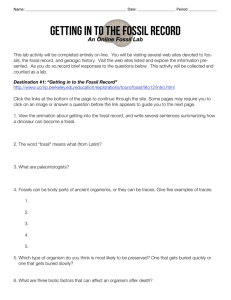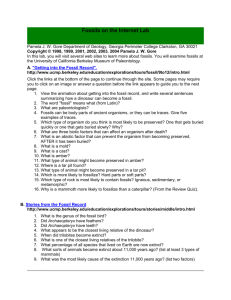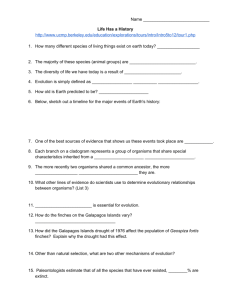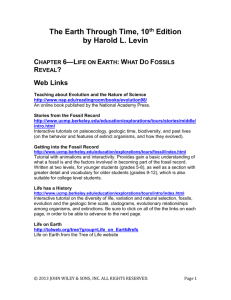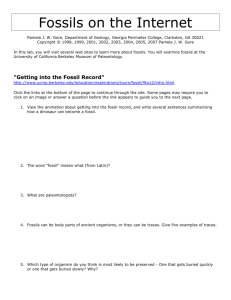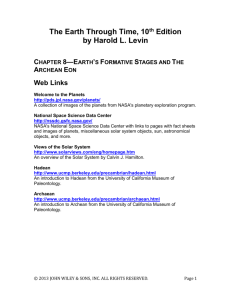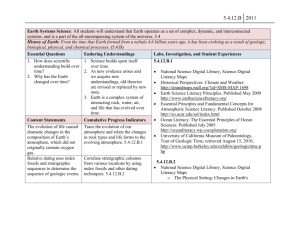JAN 2013 - University of California Museum of Paleontology
advertisement
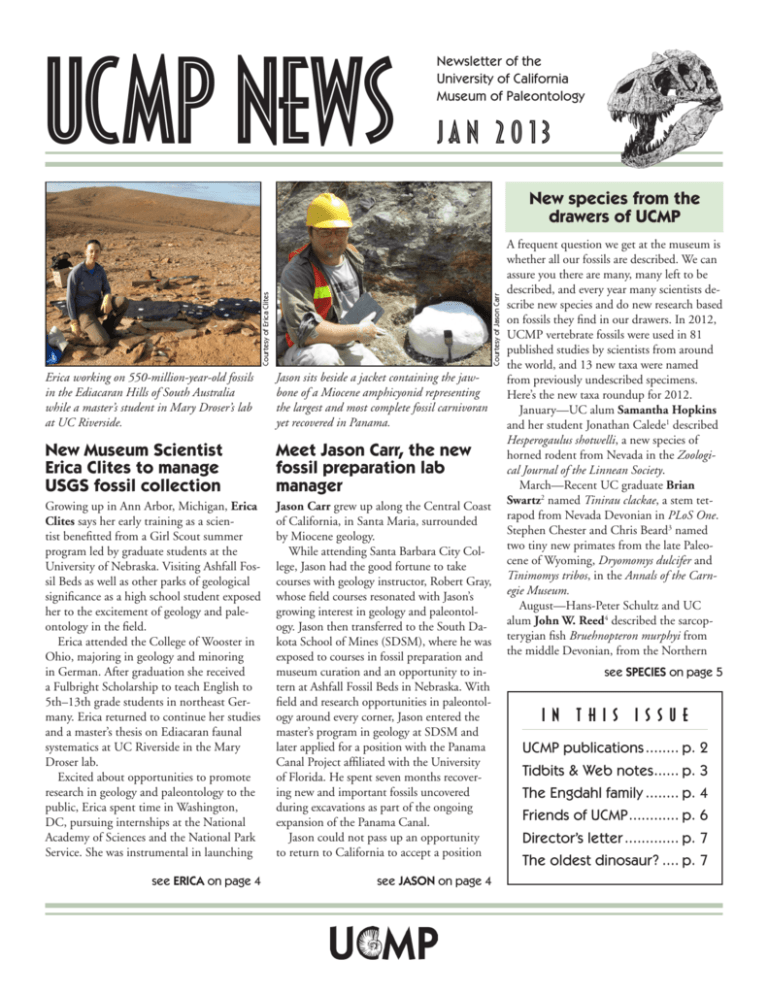
UCMP NEWS Newsletter of the University of California Museum of Paleontology JAN 2013 Courtesy of Jason Carr Courtesy of Erica Clites New species from the drawers of UCMP Erica working on 550-million-year-old fossils in the Ediacaran Hills of South Australia while a master’s student in Mary Droser’s lab at UC Riverside. Jason sits beside a jacket containing the jawbone of a Miocene amphicyonid representing the largest and most complete fossil carnivoran yet recovered in Panama. New Museum Scientist Erica Clites to manage USGS fossil collection Meet Jason Carr, the new fossil preparation lab manager Growing up in Ann Arbor, Michigan, Erica Clites says her early training as a scientist benefitted from a Girl Scout summer program led by graduate students at the University of Nebraska. Visiting Ashfall Fossil Beds as well as other parks of geological significance as a high school student exposed her to the excitement of geology and paleontology in the field. Erica attended the College of Wooster in Ohio, majoring in geology and minoring in German. After graduation she received a Fulbright Scholarship to teach English to 5th–13th grade students in northeast Germany. Erica returned to continue her studies and a master’s thesis on Ediacaran faunal systematics at UC Riverside in the Mary Droser lab. Excited about opportunities to promote research in geology and paleontology to the public, Erica spent time in Washington, DC, pursuing internships at the National Academy of Sciences and the National Park Service. She was instrumental in launching Jason Carr grew up along the Central Coast of California, in Santa Maria, surrounded by Miocene geology. While attending Santa Barbara City College, Jason had the good fortune to take courses with geology instructor, Robert Gray, whose field courses resonated with Jason’s growing interest in geology and paleontology. Jason then transferred to the South Dakota School of Mines (SDSM), where he was exposed to courses in fossil preparation and museum curation and an opportunity to intern at Ashfall Fossil Beds in Nebraska. With field and research opportunities in paleontology around every corner, Jason entered the master’s program in geology at SDSM and later applied for a position with the Panama Canal Project affiliated with the University of Florida. He spent seven months recovering new and important fossils uncovered during excavations as part of the ongoing expansion of the Panama Canal. Jason could not pass up an opportunity to return to California to accept a position see ERICA on page 4 see JASON on page 4 A frequent question we get at the museum is whether all our fossils are described. We can assure you there are many, many left to be described, and every year many scientists describe new species and do new research based on fossils they find in our drawers. In 2012, UCMP vertebrate fossils were used in 81 published studies by scientists from around the world, and 13 new taxa were named from previously undescribed specimens. Here’s the new taxa roundup for 2012. January—UC alum Samantha Hopkins and her student Jonathan Calede1 described Hesperogaulus shotwelli, a new species of horned rodent from Nevada in the Zoological Journal of the Linnean Society. March—Recent UC graduate Brian Swartz2 named Tinirau clackae, a stem tetrapod from Nevada Devonian in PLoS One. Stephen Chester and Chris Beard3 named two tiny new primates from the late Paleocene of Wyoming, Dryomomys dulcifer and Tinimomys tribos, in the Annals of the Carnegie Museum. August—Hans-Peter Schultz and UC alum John W. Reed4 described the sarcopterygian fish Bruehnopteron murphyi from the middle Devonian, from the Northern see SPECIES on page 5 I N TH I S I S S U E UCMP publications......... p. 2 Tidbits & Web notes....... p. 3 The Engdahl family......... p. 4 Friends of UCMP............. p. 6 Director’s letter.............. p. 7 The oldest dinosaur?..... p. 7 2012 UCMP publications Communicating science to both colleagues and the general public is an essential ingredient of the UCMP mission. Through journals, presentations at professional meetings, articles in the popular press, interviews, workshops, lectures, and even science cafés, members of the UCMP community share their research that ultimately contributes to a greater understanding of the history of life. This list of 2012 peer-reviewed articles represents a portion of that effort. UCMP alums are indicated by asterisks. Andrews, T.M., R.M. Price, L.S. Mead, T.L. McElhinny, A. Thanukos, K.E. Perez, C.F. Herreid, D.R. Terry, and P.P. Lemmons. 2012. Biology undergraduates’ misconceptions about genetic drift. CBE Life Sciences Education 11(3):248– 259. doi: 10.1187/cbe.11-12-0107 Barnosky, A.D., E.A. Hadly, J. Bascompte, E.L. Berlow, J.H. Brown, M. Fortelius, W.M. Getz, J. Harte, A. Hastings, P.A. Marquet, N.D. Martinez, A. Mooers, P. Roopnarine, G. Vermeij, J.W. Williams, R. Gillespie, J. Kitzes, C. Marshall, N. Matzke, D.P. Mindell, E. Revilla, and A.B. Smith. 2012. Approaching a state-shift in the biosphere. Nature 486:52–58. doi: 10.1038/nature11018 Batavia, M., G. Nguyen, and I. Zucker. 2012. The effects of day length, hibernation, and ambient temperature on incisor dentin in the Turkish hamster (Mesocricetus brandti). Journal of Comparative Physiology B. doi: 10.1007/s00360-0120729-9 Batavia, M., G. Nguyen, K. Harman, and I. Zucker. 2012. Hibernation patterns of Turkish hamsters: Influence of sex and ambient temperature. Journal of Comparative Physiology B. doi: 10.1007/ s00360-012-0706-3 Belanger, C.L., E. Jablonski, K. Roy, S. Berke, A.Z. Krug, and J.W. Valentine. 2012. Global environmental predictors of benthic marine biogeographic structure. Proceedings of the National Academy of Sciences 109(35):14046–14051. doi: 2 10.1073/pnas.1212381109 Brinkman, D.B., P.A. Holroyd, and J.D. Gardner (eds.). 2012. Morphology and Evolution of Turtles. Springer Netherlands, Dordrecht. 596 pp. Brook, B.W., and A.D. Barnosky. 2012. Quaternary extinctions and their link to climate change. Pp. 179–198 in L. Hannah (ed.), Saving a Million Species: Extinction Risk from Climate Change. Island Press, Washington, D.C. Campos, E.O., D. Vihena, and R.L. Caldwell. 2012. Pleopod rowing is used to achieve high forward swimming speeds during the escape response of Odontodactylus havanensis (Stomatopoda). Journal of Crustacean Biology 32(2):171–179. doi: 10.1163/ 193724011X615596 Chiou, T.-H., A.R. Place, R.L. Caldwell, J. Marshall, and T.W. Cronin. 2012. A novel function for a carotenoid: Astaxanthin used as a polarizer for visual signaling in a mantis shrimp. Journal of Experimental Biology 215:584–589. doi: 10.1242/jeb.066019 deVries, M.S., E.A.K. Murphy, and S.N. Patek. 2012. Strike mechanics of an ambush predator: The spearing mantis shrimp. Journal of Experimental Biology 215:4374–4384. doi: 10.1242/ jeb.075317 Encinas, A., K.L. Finger, L.A. Buatois, and D.E. Peterson.** 2012. Major forearc subsidence and deep-marine Miocene sedimentation in the present Coastal Cordillera and Longitudinal Depression of south-central Chile (38°30'S– 41°45'S). Geological Society of America Bulletin 124:1262–1277. doi: 10.1130/ B30567.1 Finnegan, S., D.A. Fike, D.S. Jones, and W.W. Fischer. 2012. A temperaturedependent positive feedback on the magnitude of carbon isotope excursions. Geoscience Canada 39(3):122-131. http://journals.hil.unb.ca/index.php/ GC/article/view/19395 Finnegan, S., N.A. Heim, S.E. Peters, and W.W. Fischer. 2012. Climate change and the selective signature of the Late Ordovician mass extinction. Proceedings of the National Academy of Sciences 109(18):6829-6834. doi: 10.1073/ pnas.1117039109 Gong, Z., N.J. Matzke, B. Ermentrout, D. Song, J.E. Vendetti,* M. Slatkin, and G. Oster. 2012. Evolution of patterns on Conus shells. Proceedings of the National Academy of Sciences 109(5):E234–E241. doi: 10.1073/pnas.1119859109 Harnik, P.G., H.K. Lotze, S.C. Anderson, Z.V. Finkel, S. Finnegan, D.R. Lindberg, L.H. Liow, R. Lockwood, C.R. McClain, J.L. McGuire, A. O’Dea, J.M. Pandolfi, C. Simpson, and D.P. Tittensor. 2012. Extinctions in ancient and modern seas. Trends in Ecology and Evolution 27(11):608-17. doi: 10.1016/j. tree.2012.07.010 Hickman, C.S. 2012. A new genus and two new species of deep-sea gastropods (Gastropoda: Vetigastropoda: Gazidae). The Nautilus 126(2):57–67. Lipps, J.H., M. Dunthorn, and T. Stoeck. Fossil tintinnids. Pp. 186–197 in J.R. Dolan, D.S. Montagnes, S. Agatha, D.W. Coats, and D. Stoecker (eds.), The Biology and Ecology of Tintinnid Ciliates: Models for Marine Plankton. Wiley/Blackwell, John Wiley & Sons, Ltd. doi: 10.1002/9781118358092.ch8 Martins, L., C.A. Souto, and C. Menegola. 2012. A new genus and new species of Sclerodactylidae (Holothuroidea: Dendrochirotida) from the south-western Atlantic coast. Zootaxa 3506:54–62. Martins, L., C.A. Souto, and C. Menegola. 2012. First record of Holothuria (Theelothuria) princeps and Thyone pawsoni [Echinodermata: Holothuroidea] in the South Atlantic Ocean. Marine Biodiversity Records 5:e98. doi: 10.1017/ S1755267212000796 see PUBLICATIONS on page 6 Other news To Brian Swartz, who heads to New York to work on evolution education projects at the Howard Hughes Medical Institute. To Sarah Werning, who received an Earth Sciences Postdoctoral Fellowship from the National Science Foundation, which she will begin next September at Stony Brook University. To UCMP alum, Lorraine Casazza and her husband Tim on the arrival of their new daughter. To UCMP, in partnership with the National Center for Science Education, on receipt of a $954,000 grant from the Gordon and Betty Moore Foundation to develop a new web-based project focusing on the causes and consequences of global change. And special congratulations to our new Ph.D., Dr. Maya deVries! Welcome to new UCMP Research Associates Robert Boessenecker, Univ. of Otago, NZ Erin Meyer, CA Ocean Science Trust Jack Horner, Museum of the Rockies, Montana State University Ralph Molnar, Queensland University (retired) Jim Parham, California State Fullerton Greg Wilson, University of Washington On National Fossil Day (October 17), UCMP launched a new and improved “Fossils in US National Parks” website, featuring enhanced “searchability” and better fossil data. UCMP was invited to develop a paleontology course for UC Berkeley’s Osher Lifelong Learning Institute. Our six-week course will provide an opportunity to share current research, focusing on topics such as biostratigraphy, evolution, extinction, and new technologies that have advanced our understandings. Speakers for this course include: Mark Goodwin, Seth Finnegan, Emily Lindsey, Sarah Werning, Ashley Poust, Pat Holroyd, and Leslea Hlusko. Jere Lipps, emeritus professor/curator, and UCMP alum Nick Pyenson, now at the Smithsonian Institution, have organized and will present a symposium at the upcoming AAAS meeting in Boston, Feb. 17, on “Evolution of Giants—The Great Whales.” Six speakers will delve into the evolutionary history of these whales, development of migratory patterns, effects of sonar, and the history of whaling. Posted on the California Academy of Science website about the Understanding Science “How Science Works Flowchart:” This is a fantastic overview of a great conceptual flow chart. I really like the explanation with spider discovery. It makes me wonder if you (or someone) could do a similar bit albeit a bit longer with climate change? What I really appreciate about this flow chart and explanation is that it gets to the rigor behind the scientific endeavor which I believe isn’t well understood in the general public. On Understanding Evolution: Get them started early on paleontology! Welcome to new UCMP Museum Associates Doug Clarke, Assistant Archivist, volunteer Chuck Crumly, UC Press Claire Englander, Assistant Archivist, volunteer Eugenie Scott, Visiting Scholar, National Center for Science Education Dave Strauss, Photographer, volunteer Lisa Urry, Visiting Scholar, Mills College Web notes Tesla Monson Congratulations! table at the North Bay Discovery Day in Sonoma County attended by more than 7,000 people. UCMP graduate students Jenna Judge, Camilla Souto, and Tesla Monson (see photo above) participated in the showcase event at AT&T Park attended by more than 30,000 fans of science. The theme of the UCMP displays and activities was: Who lived here before the Giants? The UCMP fossil displays and activities were a big hit! @ Tesla Monson (left) shares a dinosaur bone with Zelda and her mom, Sasha, at the 2012 Bay Area Science Festival. For the second year in a row, UCMP participated in the Bay Area Science Festival as one of several Science@Cal exhibitors during the week-long series of science activities designed especially for children and their families on October 27–November 3, 2012. Lisa White staffed a I simply want to thank all involved in this project—I have used it in introductory college courses in the past, and just stopped by to take a look again as I prepare to use it in the next few weeks to help geology students learn about evolution. I believe I am seeing some new material on cladograms (or I didn’t appreciate it before!) and need to say in particular, that those pages are EXCELLENT, truly the best freely available resource out there. Thanks, thanks, thanks! — Professor, Department of Earth and Atmospheric Sciences, Central Michigan University Want to receive UCMP News electronically? If you would like to receive the UCMP News as a color pdf attachment, please let us know. Just send your email address to Chris Mejia at cmejia@berkeley.edu. We are trying to go green wherever possible and reduce costs, but we also understand if you prefer the usual hard copy. 3 ERICA from page 1 the first National Fossil Day with the National Park Service and received an award for her efforts. Additional experience with the National Parks was gained as a science technician at Glen Canyon National Recreation Area in Arizona where Erica managed a monitoring program for fossil sites and fossil collections in one of the largest recreation areas in the system. Starting at the UCMP in December, Erica is busy physically organizing the USGS fossil collection from Menlo Park currently at the UCMP Regatta facility in new, museum-grade cabinets. As part of a two-year NSF museum improvement grant, the USGS collection that will be rehoused at the UCMP contains over 170,000 invertebrate fossils from more than 12,000 localities. Reorganizing, relabeling, and digitally capturing the material so it can be properly archived and incorporated into the UCMP collection will be a large task and one well suited to Erica’s skills, training and interests. Erica is enthusiastic about continuing on in a career that works to improve the availability of paleontology resources in ways benefitting large communities of users. @ JASON from page 1 at the UCMP managing the fossil prep lab. Supervising undergraduate students and other volunteers in the lab, Jason and team are focusing on the Miocene fossils from the CalTrans Caldecott Tunnel 4th Bore project. Plants, fish scales, molds and casts of small invertebrates, and occasional teeth and bones of large mammals such as horse and rhinoceros are among the collection. Jason’s balance of duties include reconstructing fossils that are part of the UCMP collection. He is currently working on careful reconstruction of a phytosaur jaw bone collected by John Muir and is also reassembling a partial jaw and frill of a Dilophosaurus dinosaur collected by Sam Welles. Having received his training primarily in geology, Jason says working at the UCMP provides a great opportunity to interact more regularly with biologists and ecologists, and he looks forward to eventually returning to graduate work and to a career that involves teaching as well as paleontology research. Jason says the best thing about returning to California in October 2012 was the timing—it coincided with the Bay Area celebration of the Giants 2012 World Series win! @ The Morris Skinner Award is the Society of Vertebrate Paleontology’s way of honoring those who have added to our knowledge through their contributions to collection of scientifically significant fossils. At its annual meeting in Raleigh, North Carolina, the society honored the Engdahl family of Garfield County, Montana, for their long-term, multi-generational support of paleontological research and education. Students, staff, and faculty associated with UCMP have benefited greatly from the Engdahls’ help and hospitality. In the late 1960s, the late Harley Garbani went to the valley of Hell Creek in northeastern Montana with the goal of collecting skeletons of dinosaurs for exhibit at the Natural History Museum of Los Angeles County. He was particularly successful in his discoveries on the Engdahl Ranch. In addition to two skeletons of Tyrannosaurus rex, he discovered the remains of other non-avian dinosaurs, which were collected with the help of Lester Engdahl and his sons, Robert and Larry. On the Engdahl Ranch, Harley also discovered concentrations of fossils of mammals, lizards, turtles, and other relatively small vertebrates that lived with the dinosaurs. In 1972, Harley, who became a field research associate of UCMP, introduced Bill Clemens and students from our museum to the Engdahls and these rich concentrations of small fossils. This was the beginning of a continuing project to study the evolution of the fauna and flora that lived with the last of the dinosaurs and the survivors of the mass extinction at the end of the Cretaceous. UCMP’s collections now contain extensive samples of fossil 4 Courtesy of Bill Clemens A salute to the Engdahl family The Engdahl family includes (from left) Robert, Jane, Duane, and Cathy (Bras). plants and animals from this interval of Earth history. These continue to be the bases for a wide variety of research projects. Through the years until his death in 1995, Lester Engdahl supported UCMP field parties. For example, he helped us refurbish a homesteader’s cabin and made it available to our field crews. In the summers the cabin provided a kitchen and shelter from the more than occasional thunderstorms. The rest of the year it served as a secure storage place for field supplies. Lester’s son, Robert Engdahl, his wife Jane, and their children, Duane and Cathy, were particularly supportive and helpful. Jane and see ENGDAHLS on next page Simpson Park Range in central Nevada in the journal Historical Biology. September—Carl David Frailey and Kenneth E. Campbell, Jr.,5 named Sylvochoerus woodburnei, a new peccary from the Miocene of the Amazon in the Journal of Paleontology. The specific epithet is for Mike Woodburne, UC alum and UC Riverside emeritus professor. September also saw a slew of new turtles described by UCMP’s Howard Hutchison6: a new snapping turtle Tullochelys montanus and a new soft-shelled turtle Atoposemys entopteros from the Paleocene of Montana; three new Eocene turtles from Wyoming—a pond turtle, Psilosemys wyomingensis; a “big headed” turtle Cardichelyon rogerwoodi, and a relative of soft-shelled turtles so distantly related that it merits its own new family, Planetochelys dithyros, in the family Planetochelyidae. All these new names appear in the edited volume Morphology and Evolution of Turtles. December—Nick Longrich, BhartAnjan Bhullar, and UC alum Jacques Gauthier7 end the year with the description of two new Late Cretaceous taxa from the Hell Creek Formation in Proceedings of the National Academy of Sciences: Cerberophis robustus, a snake, and Obamadon gracilis, a lizard named in honor of our president. Who knows what new things will be described from the drawers of UCMP in 2013! — Pat Holroyd Brian Swartz SPECIES from page 1 Slab containing the skeleton of Tinirau clackae, a sarcopterygian fish, UCMP specimen 118605. See Brian Swartz’s paper in PLoS ONE. Calede, J.J.M., and S.S.B. Hopkins. 2012. Intraspecific versus interspecific variation in Miocene Great Basin mylagaulids: Implications for systematics and evolutionary history. Zoological Journal of the Linnean Society 164(2):427–450. doi: 10.1111/j.1096-3642.2011.00765.x 1 Swartz, B. 2012. A marine stemtetrapod from the Devonian of Western North America. PLoS ONE 7(3):e33683. doi: 10.1371/journal.pone.0033683 2 Chester, S.G.B., and K.C. Beard. 2012. New micromomyid plesiadapiforms (Mammalia, Euarchonta) from the Late Paleocene of Big Multi Quarry, Washakie Basin, Wyoming. Annals of the Carnegie Museum 80(2):159–172. doi: 10.2992/007.080.0204 3 Schultze, H.-P., and J.W. Reed. 2012. A tristichopterid sarcopterygian fish from the upper Middle Devonian of Nevada. Historical Biology: An International Jour- 4 nal of Paleobiology 24(4):425–440. doi: 10.1080/08912963.2012.673599 Frailey, C.D., and K.E. Campbell, Jr. 2012. Two new genera of peccaries (Mammalia, Artiodactyla, Tayassuidae) from Upper Miocene deposits of the Amazon Basin. Journal of Paleontology 86(5):852–877. doi: 10.1666/12-012.1 5 Hutchison, J.H. 2012. New turtles from the Paleogene of North America. Pp. 477–497 in D.B. Brinkman, P.A. Holroyd, and J.D. Gardner (eds.), Morphology and Evolution of Turtles. Springer Netherlands, Dordrecht. doi: 10.1007/978-94-007-4309-0_26 6 Longrich, N.R., B.-A.S. Bhullar, and J.A. Gauthier. 2012. Mass extinction of lizards and snakes at the Cretaceous-Paleogene boundary. Proceedings of the National Academy of Sciences. doi: 10.1073/ pnas.1211526110 @ 7 ENGDAHLS from previous page her children “caught the bug” and became skilled in prospecting for vertebrate fossils. Many summer field seasons opened with expeditions to collect fossils or evaluate sites that they had discovered. Field work in Garfield County continues to be more than just collecting old bones, shells, and leaves. Since 1972 over fifty undergraduate and graduate students from Berkeley and other universities have come to Garfield County in the summer to learn collecting and research techniques. Nine of these students from UCMP completed research for their Ph.D. degrees making use of information on the geology and fossils collected in the area. This involvement continues as the Engdahls support the work of field parties from the University of Washington and the Burke Museum led by UCMP alumnus Greg Wilson. Jane Engdahl and Cathy Engdahl Bras attended the meeting in Raleigh and received the Skinner Award. We add our thanks for all they and their family have contributed to the success of UCMP’s programs of research and education. @ — Bill Clemens 5 PUBLICATIONS from page 2 Martins, L., C.A. Souto, W.F. Magalhaes, O.F.S. Alves, I.L. Rosa, and C. Sampaio. 2012. Echinoderm harvesting in Todos-os-Santos Bay, Bahia state, Brazil: The aquarium trade. Sitientibus série Ciências Biológicas 12(1):53–59. Nesbitt, S.J., P.M. Barrett, S. Werning, C.A. Sidor, and A.J. Charig. 2012. The oldest dinosaur? A Middle Triassic dinosauriform from Tanzania. Biology Letters 9(1). doi: 10.1098/rsbl.2012.0949 (published 5 December 2012) Padian, K. 2012. Evolutionary physiology: A bone for all seasons. Nature 487:310–311. doi: 10.1038/nature11382 Padian, K., and E.K. Burton. 2012. Dinosaurs and evolutionary theory. Pp. 1057–1072 in J.O. Farlow and M.K. Brett-Surman (eds.), The Complete Dinosaur (2nd ed.). University of Indiana Press, Bloomington. Parham, J.F.,* P.C.J. Donoghue, C.J. Bell,* T.D. Calway, J.J. Head, P.A. Holroyd, J.G. Inoue, R.B. Irmis,* W.G. Joyce, D.T. Ksepka, J.S.L. Patané, N.D. Smith, J.E. Tarver, M. Van Tuinen, Z. Yang, K.D. Angielczyk,* J. Greenwood, C.A. Hipsley, L. Jacobs, P.J. Makovicky, J. Müller, K.T. Smith,* J.M. Theodor,* R.C.M. Warnock, and M.J. Benton. 2012. Best practices for justifying fossil calibrations. Systematic Biology 61(2):346–359. doi: 10.1093/sysbio/ syr107 Rohrssen, M., G.D. Love, W.W. Fischer, S. Finnegan, and D.A. Fike. 2012. Lipid biomarkers record fundamental changes in the microbial community structure of tropical seas during the Late Ordovician Hirnantian glaciation. Geology. 4 pp. doi: 10.1130/G33671.1 Stegner, M.A., and M. Holmes. 2012. Using palaeontological data to assess mammalian community structure: Potential aid in conservation planning. Palaeogeography, Palaeoclimatology, Palaeoecology. doi: 10.1016/j. palaeo.2012.04.019 6 friends of ucmp We would like to welcome the following new or renewing members to our Friends of UCMP: Benefactor Harlan Spiva Suzanne Berry* Michael Wood Arthur Boucot* Sustaining Bill and Dorothy Clemens Mary E. Arbogast Thomas Debley Helen Cagampang Stephen and Barbara Morris James W. Downs Dr. Todd R. Olson Noel Engel Sponsor Louis and Georgette Grivetti Beth Burnside John and June Hopkirk Marc and Linda Carrasco Gregg Keeling Stuart Gordon Robert Kirby, Jr. Theophan Lyman Patron John Mawby Nicoline Chambers Bruce Townley Doug and Sally Clarke Kathleen Zoehfeld Ladd Coates Claire Englander Donor David Gan Gigi Babcock and Ralph Miller III Marian González Paul Babwin Sue Hoey Dennis Fenwick and Martha Lewis Randy Irmis Josephine Fong Rebecca Jabbour Joseph Huston Sandy and Ron Linder Flory Nye-Clement and Charley Mehdi Mohtashemi Clement Chris Opp Diana Prola Adele Panofsky Jack and Mary Stirton Donald Pecko Diana Thatcher Richard and Antonia Rodrigues *Designates a donation to the Barry Roth William B.N. Berry Memorial James and Jo Sanders Research Fund Suzanne Scott Valentine, J.W. 2012 (originally published in 1969). Patterns of taxonomic and ecological structure of the shelf benthos during Phanerozoic time. Palaeontology 12:684–709. Republished in M.J. Benton, ed., Origins of Biodiversity. Palaeontology Online, No. 1. Valentine, J.W., and D. Jablonski. 2012 (originally published in 2010). Origins of marine patterns of biodiversity: some correlates and applications. Palaeontology 53:1203–1210. Republished in M.J. Benton, ed., Origins of Biodiversity. Palaeontology Online, No. 1. doi: 10.1111/j.1475-4983.2010.01005.x Werning, S. 2012. The ontogenetic osteohistology of Tenontosaurus tilletti. PLoS ONE 7(3): e33539. doi: 10.1371/ journal.pone.0033539 Williams, B.L., M. Stark, and R.L. Caldwell. 2012. Microdistribution of tetrodotoxin in two species of Blue-ringed Octopuses (Hapalochlaena lunulata and Hapalochlaena fasciata) detected by fluorescent immunolabeling. Toxicon 60(7):1307–1313. doi: 10.1016/j.toxicon.2012.08.015 @ Letter from the Director Reflecting on 2012 This last year has seen exciting growth in UCMP: four new hires that span the breadth of the Museum—a new faculty member, a new Director of Education and Outreach, and two new staff members that have enabled us to re-open the fossil preparation lab and to launch our first NSF-funded collections improvement grant in a decade; four new graduate students; three amazing new volunteers; three new Ph.D.s; five new grants; and, four new research associates. On top of that we have our award-winning websites, 493 elementary students who learned about the history of life thanks to our ongoing graduate student docent program, record attendance at our 2012 UCMP short course and Evo Summer Institute for teachers, and participation in various regional events including the Bay Area Science Fair (see page 3). And all this activity does not include the individual awards, grants, publications, presentations, and other recognitions achieved by members of the UCMP community. It is very gratifying to see UCMP firing on all cylinders! And I would be remiss if I did not mention all of you who have offered support to our research and education programs through donations as Friends of UCMP. We are extremely grateful to you all for your commitment to UCMP. I cannot wait to see what unfolds in 2013! Sincerely, Charles Marshall were known from the Late Triassic of Argentina, but the new specimen—Nyasasaurus parringtoni—pushes dinosaur origins back another 10–15 million years to the Middle Triassic. The find lends support to phylogenetic analyses that had predicted Dinosauria had Middle Triassic roots. Although the Nyasasaurus material consisted of just a humerus and six vertebrae, a morphological study revealed several shared dinosaurian characters and Sarah’s histological analysis of the bones showed that, like dinosaurs, Nyasasaurus bone grew at a rapid, sustained rate. @ The oldest dinosaur? Paleontologists don’t always have to go into the field to make new discoveries. Bones found in the collections of The Natural History Museum in London, collected some 80 years ago in southern Tanzania, may belong to one of the earliest known dinosaurs. This news was reported online in Biology Letters1 by UCMP alum Sterling Nesbitt and current UCMP grad student Sarah Werning in December. Until this latest discovery, the oldest well-dated and unambiguous dinosaurs Nesbitt, S.J., P.M. Barrett, S. Werning, C.A. Sidor, and A.J. Charig. 2012. The oldest dinosaur? A Middle Triassic dinosauriform from Tanzania. Biology Letters 9(1). doi: 10.1098/rsbl.2012.0949 1 To become a Friend ▼ ✄ Your gift to the University of California Museum of Paleontology helps support research, education, and public outreach at the largest, most interactive university paleontology program in America. Become a Friend of UCMP! Name Address City StateZip Phone E-mail Benefactor $1000 Sponsor $500 Patron (annual) $100 Sustaining (annual) $50 Donor (annual) $25 New Renewal Please make checks payable to UC Regents. Mail your check and this form to: University of California Berkeley, Museum of Paleontology, 1101 VLSB #4780, Berkeley CA 94720-4780 All membership fees and donations are tax-deductible to the limit allowed by law 7 University of California, Berkeley Museum of Paleontology 1101 Valley Life Sciences Building # 4780 Berkeley, CA 94720-4780 Who is UCMP? Director: Charles Marshall Assistant Directors: Mark Goodwin Lisa White Judy Scotchmoor Faculty Curators: Anthony Barnosky Jere Lipps* Roy Caldwell Cindy Looy William Clemens* Charles Marshall Seth Finnegan Kevin Padian Carole Hickman* James Valentine* Leslea Hlusko Tim White David Lindberg Curatorial Associates: Walter Alvarez Roger Byrne Lynn Ingram Admin. Assistant: Chris Mejia Museum Scientists: Erica Clites Ken Finger Diane Erwin Patricia Holroyd Prep Lab Manager: Jason Carr Education & Public Outreach: Josh Frankel Anna Thanukos David K. Smith Edited by Judy Scotchmoor and Lisa White; layout & graphics by David K. Smith For the broader UCMP community, visit the UCMP website: www.ucmp.berkeley.edu; Understanding Evolution: evolution.berkeley. edu; and Understanding Science: www.understandingscience.org *emeritus Coming Saturday, February 23 … ** Note the venue change ** 10 Evans Hall, UC Berkeley campus 9:00 am to 3:30 pm The genome sequence of an organism includes the collective DNA sequences of each chromosome in the organism, whether it be a bacterium, a honey bee, or a chimpanzee. Unraveling and comparing genomes informs our understanding of evolution, biodiversity, conservation, and the very essence of life. From the basics of genome sequencing to horizontal gene transfer and jumping genes, this short course will focus on what we have learned and why it matters. For more information and to register, see: http://www.ucmp.berkeley.edu/about/shortcourses/shortcourse13.php This short course is cosponsored by the Berkeley Natural History Museums (BNHM) and Science@Cal.
